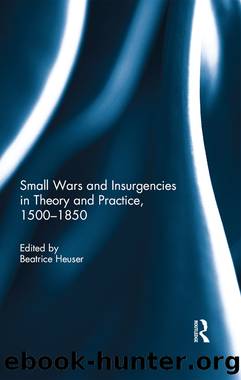Small Wars and Insurgencies in Theory and Practice, 1500-1850 by Beatrice Heuser

Author:Beatrice Heuser [Heuser, Beatrice]
Language: eng
Format: epub
ISBN: 9781138941670
Barnesnoble:
Publisher: Taylor & Francis
Published: 2015-11-06T00:00:00+00:00
Insurgency and counter-insurgency similarities between the Peninsular and Carlist Wars
The first similarity is human, and one that is significantly elitist in nature. A majority of Peninsular War guerrilla veterans who either retained, or returned to, elite military and political commands in 1833, and who were not intimately associated with the three Carlist heartlands (see below), fought on the Cristino rather than the Carlist side. Leftist historians have celebrated this Left-political recovery of guerrilla leadership as a welcome corrective to the Royalist War and a partial return to the national liberation promise of the Peninsular War.16 And certainly, even two prominent Peninsular War veterans who were intimately associated with the Basque country (Espoz y Mina, Jaúregui), fought on the Cristino side.
This elitist observation, however, obscures a far more profound subaltern phenomenon, which was reactionary rather than liberal in nature. The vast majority of irregular combatants who took to arms from 1833 did so for Carlism rather than liberalism. Indeed, this phenomenon was not restricted to the insurgent heartlands, but also applied by degrees to the patchy areas of Carlist support. In many cases, subalterns joined Carlist guerrilla leaders who boasted of their exploits against the French a generation earlier.
No exact figures exist but they range from commanders of large-scale (more than 3000 effectives) to medium (500â3000) and small-scale (fewer than 500) forces. The most prominent veteran commanding large-scale forces was Jerónimo Merino (alias El Cura), who from his traditional support base in rural Burgos province during the early stages of the war carried out a failed march on Madrid.17 In rural Castellón (the eastern zone), a veteran commanding medium-scale forces was José Miralles (alias El Serrador), an illiterate woodsman who besieged Cristino militia and army garrisons.18 In rural New Castile (now Castilla la Mancha) a veteran commanding small-scale forces was Manuel Adame (alias El Locho), of even humbler social origins than Miralles.19 All three were also veterans of the Royalist War. The most famous Carlist guerrilla commander of the Carlist War, Tomás de Zumalacárregui, commander-in-chief of Carlist forces in the Basque country between 1834 and 1835, was also a veteran of both wars, but at a subordinate rank during 1808â1814. Ramón Cabrera, commander-in-chief of Carlist forces in the Maestrazgo between 1835 and 1840, was younger and new to fighting in 1833. While the Carlist order of battle varied across Spain, three common categories may be identified in its officers. The first comprised the veterans of the Royalist War (1820â1823), the second, most reactionary, category comprised those who rose to command during the 1833 rising, while the third category comprised foreign officers. The last included both long-standing members of the Spanish army hierarchy with careers stretching back to before 1833 (to as early as the 1790s in the case of Penne de Villemur) and international volunteers who came to Carlist Spain after 1833. Many of these â especially the sizeable German contingent â brought technical application to the Carlist war effort.20
The second similarity is geographical, both at regional and local levels. Regionally,
Download
This site does not store any files on its server. We only index and link to content provided by other sites. Please contact the content providers to delete copyright contents if any and email us, we'll remove relevant links or contents immediately.
| Africa | Americas |
| Arctic & Antarctica | Asia |
| Australia & Oceania | Europe |
| Middle East | Russia |
| United States | World |
| Ancient Civilizations | Military |
| Historical Study & Educational Resources |
Never by Ken Follett(2879)
The Man Who Died Twice by Richard Osman(2297)
Machine Learning at Scale with H2O by Gregory Keys | David Whiting(2285)
Fairy Tale by Stephen King(2063)
Will by Will Smith(2040)
Rationality by Steven Pinker(1764)
The Dawn of Everything: A New History of Humanity by David Graeber & David Wengrow(1570)
The Dark Hours by Michael Connelly(1568)
Principles for Dealing With the Changing World Order: Why Nations Succeed and Fail by Ray Dalio(1373)
Friends, Lovers, and the Big Terrible Thing by Matthew Perry(1327)
A Short History of War by Jeremy Black(1299)
HBR's 10 Must Reads 2022 by Harvard Business Review(1255)
Go Tell the Bees That I Am Gone by Diana Gabaldon(1234)
Can't Hurt Me: Master Your Mind and Defy the Odds - Clean Edition by David Goggins(1227)
515945210 by Unknown(1207)
Fear No Evil by James Patterson(1107)
443319537 by Unknown(1071)
Works by Richard Wright(1018)
Going There by Katie Couric(991)
